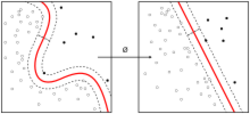Logistic model tree
| Machine learning and data mining |
|---|
 |
In computer science, a logistic model tree (LMT) is a classification model with an associated supervised training algorithm that combines logistic regression (LR) and decision tree learning.[1][2]
Logistic model trees are based on the earlier idea of a model tree: a decision tree that has linear regression models at its leaves to provide a piecewise linear regression model (where ordinary decision trees with constants at their leaves would produce a piecewise constant model).[1] In the logistic variant, the LogitBoost algorithm is used to produce an LR model at every node in the tree; the node is then split using the C4.5 criterion. Each LogitBoost invocation is warm-started[vague] from its results in the parent node. Finally, the tree is pruned.[3]
The basic LMT induction algorithm uses cross-validation to find a number of LogitBoost iterations that does not overfit the training data. A faster version has been proposed that uses the Akaike information criterion to control LogitBoost stopping.[3]
References
- ↑ 1.0 1.1 Niels Landwehr; Mark Hall; Eibe Frank (2003). "Logistic model trees". ECML PKDD. http://www.cs.waikato.ac.nz/~ml/publications/2003/landwehr-etal.pdf.
- ↑ Landwehr, N.; Hall, M.; Frank, E. (2005). "Logistic Model Trees". Machine Learning 59 (1–2): 161–205. doi:10.1007/s10994-005-0466-3. http://www.cs.waikato.ac.nz/~eibe/pubs/LMT.pdf.
- ↑ 3.0 3.1 Sumner, Marc; Eibe Frank; Mark Hall (2005). "Speeding up logistic model tree induction". PKDD. Springer. pp. 675–683. http://www.cs.waikato.ac.nz/~ml/publications/2005/SumnerFrankHallCameraReady.pdf.
See also
 |

